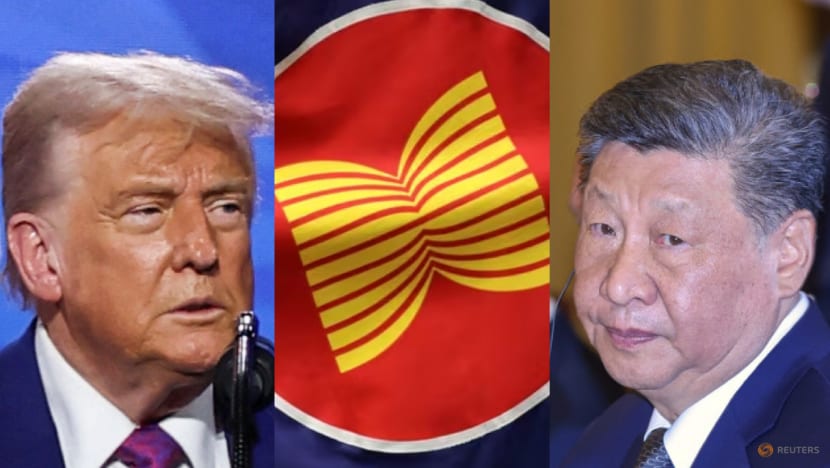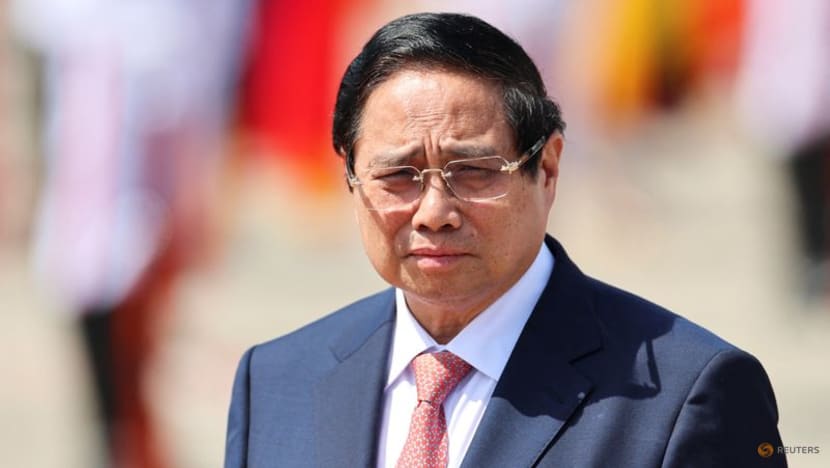analysis Asia
‘Risk being sidelined’: US-China trade truce raises stakes for ASEAN members seeking lower Trump tariffs
Southeast Asian countries such as Malaysia, Vietnam, Indonesia and Thailand can ill afford to emerge from US talks with higher tariff rates than China, say analysts.

Composite photo of US President Donald Trump, the ASEAN flag and Chinese President Xi Jinping. (Photos: Reuters)

This audio is generated by an AI tool.
KUALA LUMPUR: A temporary deal struck between the United States and China on Monday (May 12) that put the brakes on an escalating trade war has raised the stakes for Southeast Asian countries trying to negotiate tariff reductions with Washington, analysts say.
With the 90-day deal between the two global powers, Southeast Asian countries will race to wrap up trade talks with the US, as the clock ticks towards a Jul 8 deadline when Washington might reinstate steeper “reciprocal” tariff rates slapped on most countries in the world.
Southeast Asian countries, hit with some of the harshest tariff rates, will be wary of emerging from US talks with higher rates than China as this will hurt their competitiveness and investment appeal, observers said.
After talks in Geneva last weekend, the US agreed to lower tariffs on Chinese goods to 30 per cent, down from the previous 145 per cent.
This 30 per cent rate comprises the 10 per cent baseline rate and 20 per cent punitive levies aimed at curbing China’s export of chemicals used to make fentanyl, an opioid that has caused tens of thousands of deaths in the US.
In return, China agreed to lower its retaliatory 125 per cent tariffs on US goods to the baseline 10 per cent.
Talks on a more comprehensive trade agreement are set to continue before the truce expires on Aug 12.
If Beijing ends up with a lower US tariff rate than Southeast Asian countries after Aug 12, the latter’s relative attractiveness as an investment and manufacturing alternative to China could be “diminished”, said Joanne Lin, senior fellow and co-coordinator of the Association of Southeast Asian Nations (ASEAN) Studies Centre at Singapore’s ISEAS-Yusof Ishak Institute.
“This is especially concerning for countries like Vietnam, Malaysia and Indonesia, which have benefited from Chinese firms relocating production during the height of the US-China trade tensions,” she said.
“A lower tariff regime for China would reduce the incentive for these relocations and could slow foreign direct investment inflows to ASEAN tied to supply chain diversification.”
Vietnam, Malaysia and Indonesia are understood to be part of US President Donald Trump’s so-called “Dirty 15” list of nations that account for the bulk of US trading volume but have supposedly imposed hefty tariffs and other non-tariff barriers on US goods.
The trio is also believed to be part of a list of roughly 20 countries that Bloomberg reported on May 10 are the focus of early negotiations with the US, with those in Southeast Asia considered a priority.
US Trade Representative Jamieson Greer told CNBC on May 9 that Washington is “having fruitful talks with Vietnam and others, and they understand what we’re trying to solve for”.
“The outcomes of bilateral negotiations between US and ASEAN countries will thus be important to determine if Southeast Asian countries can maintain their competitive edge or risk being sidelined in a reconfigured global trade landscape,” Lin said.
INDONESIA “LEFT BEHIND”, THAILAND “PASSIVE”, MALAYSIA YET TO COMMIT
This fear could well become reality in Indonesia, whose economy is vulnerable to the potential effects of a trade war and is currently negotiating a potential 32 per cent US tariff rate.
Jakarta has proposed to increase its annual imports from the US by up to US$19 billion by switching to US suppliers for goods such as wheat, soybean, liquefied petroleum gas (LPG) and crude.
The country has issued new rules to allow the government to procure goods with lower locally-produced content, addressing a jarring non-tariff barrier identified by the US, Reuters reported on May 6.
While the temporary deal between the US and China spells good news for Indonesia’s raw material exports to China, whose factories are rushing to ship goods to the US, Southeast Asia as a whole might suffer if Beijing eventually gets a much lower tariff rate than ASEAN countries, said Bhima Yudhistira Adhinegara, director of the Center of Economic and Law Studies in Indonesia.
“There will be many investments from China going back again to China. There will be a relocation of the Southeast Asian factories back to China again,” he told CNA.
“Investment from Europe and the US will be flowing to China. So, I think this also makes for negative signs for each individual member country in ASEAN pushing for more negotiations with the US.”
Bhima feels Indonesia – Southeast Asia’s largest economy – has been “left behind” in negotiations with the US compared to China, noting how the latter has managed to secure a temporary but substantial discount on its own tariff rates.
“I think China made really good progress compared with Indonesia, of which we don't see the outcome of the negotiation process yet,” he said, citing challenges that come with the concessions Jakarta has proposed.
“If Indonesia buys more LPG or imports more oil from the US, there will be a huge burden (on) the state budget, to the fiscal space.”
While talks between Indonesia and the US are ongoing, Thailand’s negotiation on its 36 per cent US tariff rate seems to have stalled.
A meeting between Thai and US officials scheduled for Apr 23 was cancelled after Thai officials based in the US reportedly wanted to review specific issues that would be raised in the negotiations.
Thailand has offered to step up imports of US commodities such as corn, natural gas and ethane, besides reducing import duties and removing non-tariff barriers to secure a deal.
The latter includes stricter inspection of goods shipped to the US, to prevent counterfeiting by third countries trying to dodge the high tariffs they face.
Thai premier Paetongtarn Shinawatra said on May 4 that her government remains in informal contact with US trade officials, and that she was confident talks would start before the 90-day pause lapses.
Paetongtarn said a “secret deal” with the US remains a possibility, the Bangkok Post reported, and that her government was “discussing the details of what it might achieve, and how flexible it could be”.
Reuters reported on Tuesday that Thailand has sent a trade proposal to the US, quoting Paetongtarn as saying officials were “waiting for the right time” to make an appointment for talks with Washington.
But a Thai analyst told CNA that “public discontent” appears to be brewing in Thailand after it apparently emerged that the country was not among the 20 nations to get early talks with the US, bringing Paetongtarn “dangerously close to the knife’s edge”.
“If no deal is reached before Jul 8, tariffs on products from ASEAN could surpass those imposed on Chinese goods,” said Wannaphong Durongkaveroj, an economics professor at Ramkhamhaeng University.
“The US-China deal underscores the need for ASEAN – particularly Thailand, which has yet to initiate official talks with the US – to develop a clear and comprehensive strategy.”
That said, Wannaphong believes there is “limited value” in drawing lessons for Southeast Asia from the US-China agreement, noting that Beijing is the primary focus of Trump’s trade policy.
“What the deal does highlight, however, is the high level of uncertainty and the political cost for the Thai government of remaining in a passive, wait-and-see posture,” he said.
“There is clearly a race among ASEAN leaders to secure bilateral deals with Trump,” Wannaphong added.
Thailand’s neighbour Malaysia sent a delegation to Washington from Apr 22 to Apr 24, and Prime Minister Anwar Ibrahim told parliament on May 5 that Putrajaya could possibly negotiate a reduction on its threatened 24 per cent tariff rate.
Malaysia has said it is open to negotiating with the US on non-tariff barriers, reducing its bilateral trade surplus, and exploring a bilateral trade agreement.
These include strengthening technological safeguards and security, although few concrete details have been released.
Asrul Hadi Abdullah Sani, a partner at strategic advisory firm ADA Southeast Asia, told CNA that the US is unlikely to consider any tariff negotiations if Malaysia “does not bring numbers to the table” in reducing its trade surplus with Washington.
Malaysia must commit to increasing imports of US agricultural goods, machinery, technology and pharmaceutical products, as well as streamline and simplify processes for US goods to make the Malaysian market more accessible, he said.
“Crucially, foreign companies have advocated for the Malaysian government to relax its regulations and non-tariff barriers, even before Trump's Liberation Day,” Asrul Hadi said, referring to the initial announcement of reciprocal tariffs on Apr 2.
“This includes easing import controls, bumiputera requirements, and product regulations.”
VIETNAM THE FRONTRUNNER TO STRIKE A DEAL?
Bhima from the Center of Economic and Law Studies said Vietnam, which is facing a 46 per cent tariff rate, appears to be the Southeast Asian frontrunner in striking a deal with the US.
Vietnam started official talks with the US on May 7, and Reuters reported on Tuesday that the country is stepping up its fight against counterfeits and digital piracy after the US accused it of being a major hub for such illicit activities.
Hanoi has dangled zero tariffs on US imports and pledged to buy much more US goods, such as Boeing planes and liquified natural gas. The government has also urged local manufacturers to buy American.
A major regional manufacturing base for many Western companies, Vietnam racked up a trade surplus of more than US$123 billion with the US last year.

Earlier in April, Vietnamese Prime Minister Pham Minh Chinh said his country would buy more American weapons as part of efforts aimed at addressing the trade imbalance with the US.
Hanoi’s reported agreement to buy “no less than 24” Lockheed Martin F-16 fighter jets has created headlines. In an Apr 22 article, The Diplomat, a current affairs analysis site, said such a major US arms purchase would “at the very least send some tremors” in its relationship with China.
The American defence industry needs to expand to new markets in Southeast Asia, Bhima said, making the US more amenable to offers such as arms purchases in tariff negotiations.
“So if any individual country in Southeast Asia talks about defence cooperation, I think they will be the winner,” he said.
Many Southeast Asian countries are already offering to buy more American oil and gas, and Bhima said it would be a missed opportunity for Indonesia not to bring up greater cooperation with the US on the South China Sea.
ASEAN members Malaysia, Vietnam, Brunei and the Philippines have overlapping claims with China in the strategic and resource-rich waterway, most of which Beijing claims as its own.
Indonesia is not a direct South China Sea claimant but China’s “nine-dash line” overlaps with Indonesia’s exclusive economic zone near the oil- and gas-rich Natuna Islands.
“The Indonesian government still thinks that this is like a trade negotiation only; it's not involving any political kind of negotiation. So, that’s a little bit naive,” Bhima added.
“We also missed talking about buying more US weapons. But I don't know, maybe the Indonesian government is afraid of Russia, China and France also, because we are already buying Rafale fighter jets from France.”

ISEAS’ Lin said ASEAN countries are adopting different negotiation strategies with the US based on their strategic priorities, economic feasibility and domestic political considerations.
“However, balancing trade via increased imports may be more straightforward than addressing US concerns over non-tariff barriers,” she said, referring to accusations that some ASEAN countries might be serving as transshipment hubs for Chinese goods to evade US tariffs.
Negotiating non-tariff barriers is tricky as some policies, such as those related to public health, safety or national security, are grounded in legitimate regulatory frameworks, Lin explained.
“In contrast, more negotiable non-tariff barriers such as product standards or customs procedures can be modified or clarified more easily,” she said.
Ultimately, Lin said differences in outcomes were “inevitable” as some Southeast Asian countries might be able to negotiate steeper US tariff reductions depending on what they can offer in return, be it increased imports of US goods, defence cooperation or regulatory concessions.
“If these countries are seen as more ‘aligned’ with US interests or offer greater market access, they could become relatively more attractive destinations for foreign direct investments from companies in China or other third countries seeking tariff-resilient hubs,” she added.
“This could give certain ASEAN economies a temporary edge in regional supply chain positioning.”
The two deals the US reached with the United Kingdom and China, however, suggest that the baseline tariff rate of 10 per cent is here to stay, said Deborah Elms, who heads trade policy at the Asia-based Hinrich Foundation.
This means the US is unlikely to reduce its tariff rates to zero, she told CNA, making it less worthwhile for countries like Malaysia and the Philippines – which face the third- and second-lowest tariff rates in ASEAN at 24 per cent and 17 per cent respectively – to make “serious concessions” to the US.
“I’m not sure how ASEAN members might take requests to manage Chinese content in their supply chains. It was always a tough ask,” she said.
“But with US-China talks now stretching at least 90 days, it might be harder for ASEAN members to agree as they won’t know what broader package (agreed between the US and China) might be ahead.”
Lin said the US is likely looking for “tangible, sector-specific concessions” from Southeast Asian countries, while Elms pointed to an increasing need for them to discuss current and future sectoral tariffs with the US.
The US has applied a 25 per cent sectoral tariff on steel, aluminium and products made with these metals, as well as autos and auto parts.
“The first two are 25 per cent. The rest may be the same, higher or lower,” Elms said, noting in a separate commentary that semiconductors, pharmaceuticals, lumber, copper, heavy trucks, and critical minerals could be next in line.
“For Malaysia, semiconductors are in the pipeline with a definition of the sector that is extremely broad. If these products end up tariffed at high rates, that is likely to be more damaging than reciprocal tariffs.”
ASEAN UNITY OR NATIONAL INTEREST FIRST?
As this year’s ASEAN chairman, Anwar had said on Apr 6 that Malaysia will lead efforts to present a “united regional front” in the face of US tariffs.
A joint statement by ASEAN economic ministers after a special Apr 10 meeting on the tariffs expressed a “common intention to engage in a frank and constructive dialogue with the US”, while not imposing retaliatory tariffs.
They said ASEAN will also deepen regional economic integration, and continue to discuss ways to further strengthen and boost intra-ASEAN trade.

But observers previously told CNA that it would be most realistic for ASEAN to adopt a “hybrid approach” in addressing US tariffs.
This involves speaking with one voice to highlight the bloc's shared concerns while allowing member states to negotiate individually based on their own interests.
“Unlike the European Union, ASEAN is not a supranational union and does not have a single market through which it can engage the US collectively,” Asrul Hadi said.
“This is even more so given that each member state has varying tariff levels. Each country will have its own economic interests, outweighing the overall interests of ASEAN.”
The ASEAN statement on Apr 10 serves more as a symbolic show of unity than a negotiating tool, especially given the Trump administration’s clear preference for bilateral transactional deals, Lin added.
“National-level strategies may undercut ASEAN’s cohesion or inadvertently disrupt intra-regional trade flows but in a fragmented global trade environment, some degree of competition is inevitable.”
There are already signs that offers made in individual negotiations between ASEAN member states and the US could disrupt intra-ASEAN trade.
Thai PM Paetongtarn stated that any “secret collaboration” with the US on trade cannot be disclosed, as other countries in similar negotiations “will know and comparisons will be made and turmoil will follow”.
Indonesia’s Energy Minister Bahlil Lahadalia said his country plans to change the source of some of its fuel imports from Singapore to the US as part of negotiations, Reuters reported on May 9.
Indonesia could shift as much as 60 per cent of its total fuel imports from Singapore to the US in the early stages of what would be a gradual process, he said.
Previously, there were “high hopes” Indonesia could work with other ASEAN trading partners in discussing tariffs with the US, Bhima said.
“But perhaps it's very, very pragmatic to see that Donald Trump does not like multilateralism and instead prefers going to individual countries,” he said.
“That's why Indonesia is also going to be more pragmatic - national interest first, even though they will disappoint Singapore or other ASEAN members.”
Wannaphong said he does not believe individual negotiations with the US would necessarily undermine ASEAN unity.
But he added “it remains unclear to me what ASEAN, as a bloc, can realistically do - especially when the region is among the hardest hit by Trump’s tariffs”.























